 |
 |
 |
 |
 |


 |
|
 |
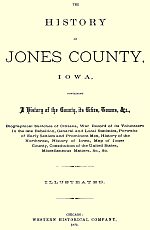
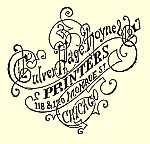


 Anamosa Avenue, looking west, Onslow, Iowa. Anamosa Avenue, looking west, Onslow, Iowa.

|
|
MADISON TOWNSHIP
  This township is situated in the second tier of townships from the south, west of the township of Wyoming. The surface in general is smooth and unbroken, in parts rolling, and there is a range of low hills extending east and west through the center. There is but little timber in the township, and the inhabitants depend in a measure on the adjoining towns for wood for fuel. The farmhouses are good, the farms well cultivated, and the soil as fertile as in any part of the county. Bear Creek crosses the southern part from west to east, and a branch of Mineral Creek has its source in this township. The township makes a fine display of good schoolhouses, and the employment of good teachers bespeaks a commendable interest in the education of the rising generation. This township is situated in the second tier of townships from the south, west of the township of Wyoming. The surface in general is smooth and unbroken, in parts rolling, and there is a range of low hills extending east and west through the center. There is but little timber in the township, and the inhabitants depend in a measure on the adjoining towns for wood for fuel. The farmhouses are good, the farms well cultivated, and the soil as fertile as in any part of the county. Bear Creek crosses the southern part from west to east, and a branch of Mineral Creek has its source in this township. The township makes a fine display of good schoolhouses, and the employment of good teachers bespeaks a commendable interest in the education of the rising generation.
 Among the early settlers were Mr. Scriven, who settled in the township about the year 1855, at the place where the village of Onslow now stands. He is now dead and the family is scattered; one daughter is now living Among the early settlers were Mr. Scriven, who settled in the township about the year 1855, at the place where the village of Onslow now stands. He is now dead and the family is scattered; one daughter is now living |  |  From A. T. Andreas' Illustrated Historical Atlas of Iowa, by Alfred Theodore Andreas, Chicago, Andreas Atlas Co., 1875, page 157 (township) & page 92 (city). Printed by Lakeside Press, Chicago.
From A. T. Andreas' Illustrated Historical Atlas of Iowa, by Alfred Theodore Andreas, Chicago, Andreas Atlas Co., 1875, page 157 (township) & page 92 (city). Printed by Lakeside Press, Chicago. |
ona part of the old farm, the wife of Alex Clark, also an old settler.
 Amos Gilbert settled a half-mile north of Onslow. He died two years ago. Amos Gilbert settled a half-mile north of Onslow. He died two years ago.
 Fred Dockstader settled a quarter of a mile west of Onslow, and C. C. Himebaugh on the farm next west of him. Fred Dockstader settled a quarter of a mile west of Onslow, and C. C. Himebaugh on the farm next west of him.
 Mr. Crouse, a German, settled in the extreme north. He died some years ago. Mr. Crouse, a German, settled in the extreme north. He died some years ago.
 Jacob Bender and his brother Thomas settled in the south part of the township. Jacob Bender and his brother Thomas settled in the south part of the township.
 Horace Fay founded what was once the village of Madison in the southwest. Horace Fay founded what was once the village of Madison in the southwest.
 These are perhaps all those who might be properly called pioneers. These are perhaps all those who might be properly called pioneers.
 A few years later, the following persons were added to the settlers of the township: H. Bartow, William Hawley and family, Henry Cross, John McDonald and brothers, John Anderson, James Tuttle, M. O. Felton, John and Willard Niles. A few years later, the following persons were added to the settlers of the township: H. Bartow, William Hawley and family, Henry Cross, John McDonald and brothers, John Anderson, James Tuttle, M. O. Felton, John and Willard Niles. |
|


|
|
THE VILLAGE OF ONSLOW
 The village of Onslow is in the northwest portion of Wyoming and the northeastern part of Madison, a part in both townships. E. M. Franks, who settled in Wyoming Township some years ago, and become a large land-holder, was the proprietor of the town. The site was laid off into lots and the village begun, in the spring of 1872, on the completion of the Midland Branch of the Chicago & North-Western Railway to this point. Mr. Franks died two years ago. The village of Onslow is in the northwest portion of Wyoming and the northeastern part of Madison, a part in both townships. E. M. Franks, who settled in Wyoming Township some years ago, and become a large land-holder, was the proprietor of the town. The site was laid off into lots and the village begun, in the spring of 1872, on the completion of the Midland Branch of the Chicago & North-Western Railway to this point. Mr. Franks died two years ago.
 The site is a pleasant one, and Onslow has been an important shipping- point on this railroad. The prosperity of the village has been materially affected, in its commercial interests, by reasons of the ravages of fire. No less than three destructive fires have occurred in the business portion during its seven years existence. There are three good church edifices in the village, the Presbyterians, the Methodist and the Roman Catholic. The Rev. Mr. Goodale, Pastor of the Presbyterian Church at Wyoming, supplies the Presbyterian pulpit at Onslow, and the Rev. Charles P. Mathers, of Center Junction, the Methodist pulpit. The inhabitants of the village are nearly all Americans, and the support of the Catholic Church is principally from the surrounding country. There is a good public school of two departments, and a commendable spirit of enterprise characterizes the inhabitants of the village. There is one large general store, one hardware store, two drug stores, one grocery store, one furniture store, one agricultural implement store, one lumber-yard, one grain elevator, one confectionery store, one millinery store, one art-gallery, two blacksmith-shops, two wagon and repair shops, one cheese-factory, one livery stable, one hotel, one meat market, one harness-shop, two doctors, one dentist, one lawyer, and one saloon. The site is a pleasant one, and Onslow has been an important shipping- point on this railroad. The prosperity of the village has been materially affected, in its commercial interests, by reasons of the ravages of fire. No less than three destructive fires have occurred in the business portion during its seven years existence. There are three good church edifices in the village, the Presbyterians, the Methodist and the Roman Catholic. The Rev. Mr. Goodale, Pastor of the Presbyterian Church at Wyoming, supplies the Presbyterian pulpit at Onslow, and the Rev. Charles P. Mathers, of Center Junction, the Methodist pulpit. The inhabitants of the village are nearly all Americans, and the support of the Catholic Church is principally from the surrounding country. There is a good public school of two departments, and a commendable spirit of enterprise characterizes the inhabitants of the village. There is one large general store, one hardware store, two drug stores, one grocery store, one furniture store, one agricultural implement store, one lumber-yard, one grain elevator, one confectionery store, one millinery store, one art-gallery, two blacksmith-shops, two wagon and repair shops, one cheese-factory, one livery stable, one hotel, one meat market, one harness-shop, two doctors, one dentist, one lawyer, and one saloon.
 The stockyards are first-class, and a good deal of shipping is done. The village is not incorporated and numbers about two hundred and fifty souls. The stockyards are first-class, and a good deal of shipping is done. The village is not incorporated and numbers about two hundred and fifty souls. |
|
CENTER JUNCTION
 This village, of about the same size as Onslow, is situated on the same railroad in the northern part of the township of Madison, and also at the junction of the Chicago, Milwaukee & St. Paul Railroad with the Midland. This village is quite near the geographical center of the county, and it is owing to this fact and the railroad junction, that it was named Center Junction. This village, of about the same size as Onslow, is situated on the same railroad in the northern part of the township of Madison, and also at the junction of the Chicago, Milwaukee & St. Paul Railroad with the Midland. This village is quite near the geographical center of the county, and it is owing to this fact and the railroad junction, that it was named Center Junction.
 The proprietors of the town were Kinsey Elwood, James A. Bronson, S. W. Johnson and John M. Squares, and the village began its existence in the fall of 1872, the year in which the Midland Railroad was completed through the township. John M. Squares has since purchased of the other proprietors their interests, and now owns the vacant lots, as well as the most of the lands adjoining the village. Owing to railroad facilities, Center Junction is a good shipping-point. The village has a good public school, and there are two church edifices, owned by the Presbyterian and the Methodist societies. The Presbyterian Church was recently dedicated, is built of brick, and is an ornament to the village. The Pastor is the Rev. Daniel Russell. The Pastor of the Methodist Church is Rev. Charles P. Mathers, and the society has a neat and commodious house of worship. There are two general stores, one drug store, one hardware store, two restaurants, one millinery store, two blacksmith-shops, one wagon and repair shop, one tin-shop, one hotel, one creamery, two depots, two express offices, one harness-shop, two grain warehouses, stockyards, two doctors and no saloons. The Postmaster is Zuri G. Isbell. The proprietors of the town were Kinsey Elwood, James A. Bronson, S. W. Johnson and John M. Squares, and the village began its existence in the fall of 1872, the year in which the Midland Railroad was completed through the township. John M. Squares has since purchased of the other proprietors their interests, and now owns the vacant lots, as well as the most of the lands adjoining the village. Owing to railroad facilities, Center Junction is a good shipping-point. The village has a good public school, and there are two church edifices, owned by the Presbyterian and the Methodist societies. The Presbyterian Church was recently dedicated, is built of brick, and is an ornament to the village. The Pastor is the Rev. Daniel Russell. The Pastor of the Methodist Church is Rev. Charles P. Mathers, and the society has a neat and commodious house of worship. There are two general stores, one drug store, one hardware store, two restaurants, one millinery store, two blacksmith-shops, one wagon and repair shop, one tin-shop, one hotel, one creamery, two depots, two express offices, one harness-shop, two grain warehouses, stockyards, two doctors and no saloons. The Postmaster is Zuri G. Isbell.
 Lodge No. 245, I.O.O.F., was instituted at Center Junction in 1872, and has a membership of 35. Lodge No. 245, I.O.O.F., was instituted at Center Junction in 1872, and has a membership of 35.
 Lodge No. 160, A.O.U.W., was established in the spring of 1878, and is in a prosperous condition. The Lodge has had no losses since it was established. Lodge No. 160, A.O.U.W., was established in the spring of 1878, and is in a prosperous condition. The Lodge has had no losses since it was established.
 Much of the early history is similar or identical with that of Wyoming Township, and is given at length by Dr. Calkins, elsewhere. Much of the early history is similar or identical with that of Wyoming Township, and is given at length by Dr. Calkins, elsewhere.
|
|
OXFORD TOWNSHIP
 This is the southeastern township of the county. The Wapsipinicon River enters the township from the west, at about the center of the north and south line, and, crossing diagonally, leaves the township about a half-mile west of the southeast corner. The township, like all others in the county, is well watered. Along the Wapsipinicon there is sufficient timber for the ordinary uses of the inhabitants. Much of the land that was too wet for farming purposes years ago, now constitutes a part of the best land in the county. The township is well settled by emigrants from the Eastern States, and there is quite a large settlement of Bohemians. This is the southeastern township of the county. The Wapsipinicon River enters the township from the west, at about the center of the north and south line, and, crossing diagonally, leaves the township about a half-mile west of the southeast corner. The township, like all others in the county, is well watered. Along the Wapsipinicon there is sufficient timber for the ordinary uses of the inhabitants. Much of the land that was too wet for farming purposes years ago, now constitutes a part of the best land in the county. The township is well settled by emigrants from the Eastern States, and there is quite a large settlement of Bohemians.
 John Bryan, who was born in Ross County, Ohio, was the first settler on the north side of the river. He left Ohio with his family in 1847, and came to Iowa and settled in Linn County, whence he moved into Oxford Township in 1849, where he still resides. He did the first John Bryan, who was born in Ross County, Ohio, was the first settler on the north side of the river. He left Ohio with his family in 1847, and came to Iowa and settled in Linn County, whence he moved into Oxford Township in 1849, where he still resides. He did the first |  | 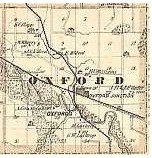 | From A. T. Andreas' Illustrated Historical Atlas of Iowa, by Alfred Theodore Andreas, Chicago, Andreas Atlas Co., 1875, page 157 (township) & page 92 (city). Printed by Lakeside Press, Chicago.
|
breaking on the north side of the river. The first settler on the south side of the river was a Mr. Strong, the father of William Strong, who settled there the year before Mr. Bryan settled north of the river. Among those who came about the same time that Mr. Bryan did, were L. Wallston and family and Samuel Coon and family. These, with Bryan and Strong, were the only inhabitants in the township until 1850. In that year, William Bowers and family came and settled in a log cabin near the river, and was driven from his home for a time during the high-water season of that year. In the fall of 1852, Miles Carter came into the settlement and bought out William Bowers and opened up what is now one of the largest farms in the county. He died some years ago, and Ira and Julius Carter carry on the farm, which comprises about a thousand acres. About the time that Carter settled here, John Waite and Francis Bennett, with their families, came and settled in the western part of the township. Bennett was drowned in the Wapsipinicon, and John Waite resides in Wyoming. He was attacked with paralysis a year ago, which rendered him entirely speechless. About 1853, Peter Moore, John Wherry and William Bratten, with their families, settled in Oxford Township, and James Bollen, now deceased, came in soon after. Clement Guthrie and George Rathbone also settled in the town not far from the same time.
 From this time on, the settlement of the township was rapid, and now it is one of the most populous in the county, aside from those in which there are large towns. From this time on, the settlement of the township was rapid, and now it is one of the most populous in the county, aside from those in which there are large towns. |
|
OXFORD JUNCTION
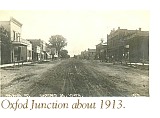 The
The village of Oxford Junction is situated about a mile north of the river, near the center of the township, and at the junction of the two branches of the Chicago, Milwaukee & St. Paul Railway, and contains near two hundred inhabitants. The site was laid off into village lots in 1871, by John Bryan. Since that time, two small additions have been laid out; one by Bryan and one by George Wilson. The C., M & St. P. Company recently purchased land at this point, and the machine-shops, etc., for those divisions are to be located here. This gives to the village an air of importance, and the prospects of its improvement are quite flattering. Already building has commenced, and another addition is to be made to the town soon. The village now contains one school of fifty pupils, a recently established village of Oxford Junction is situated about a mile north of the river, near the center of the township, and at the junction of the two branches of the Chicago, Milwaukee & St. Paul Railway, and contains near two hundred inhabitants. The site was laid off into village lots in 1871, by John Bryan. Since that time, two small additions have been laid out; one by Bryan and one by George Wilson. The C., M & St. P. Company recently purchased land at this point, and the machine-shops, etc., for those divisions are to be located here. This gives to the village an air of importance, and the prospects of its improvement are quite flattering. Already building has commenced, and another addition is to be made to the town soon. The village now contains one school of fifty pupils, a recently established
 newspaper, one church, erected by the Lutheran Church society four years ago, three dry-goods stores, one drug store, one hardware store, one restaurant, two meat markets, one harness-shop, three grain ware-houses, two wagon and blacksmith shops, three shoe-shops, one hotel and three saloons. newspaper, one church, erected by the Lutheran Church society four years ago, three dry-goods stores, one drug store, one hardware store, one restaurant, two meat markets, one harness-shop, three grain ware-houses, two wagon and blacksmith shops, three shoe-shops, one hotel and three saloons. |
|
OXFORD MILLS
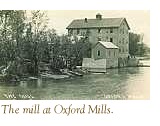 This This village, of near the size of the Junction, is situated on the south bank of the Wapsipinicon, a mile south of the above place. Its name is derived from the flouring-mill erected here about the year 1857, by Messrs. Courtright & Lathrop. It is a three-story wood building and contains the modern appointments of a first-class mill. The property has changed hands at sundry times, and is owned by S. F. McDonald, Esq. The Wapsipinicon at this point affords an excellent water-power, which, if utilized more fully, would greatly benefit the town. Messrs. Cartwright & Bristol are the proprietors of a large general store; there are two drug stores in the village, one public school, and the Methodist Church society has a good house of worship. There is also a hotel and the usual shops found in a village of the size. village, of near the size of the Junction, is situated on the south bank of the Wapsipinicon, a mile south of the above place. Its name is derived from the flouring-mill erected here about the year 1857, by Messrs. Courtright & Lathrop. It is a three-story wood building and contains the modern appointments of a first-class mill. The property has changed hands at sundry times, and is owned by S. F. McDonald, Esq. The Wapsipinicon at this point affords an excellent water-power, which, if utilized more fully, would greatly benefit the town. Messrs. Cartwright & Bristol are the proprietors of a large general store; there are two drug stores in the village, one public school, and the Methodist Church society has a good house of worship. There is also a hotel and the usual shops found in a village of the size. |
|
HALE TOWNSHIP
 This This township was named in honor of the Hon. J. P. Hale, at the suggestion of Daniel Garrison, who was the first settler of the township. The township of Hale is situated west of Oxford and east of Rome, in the southern tier of townships in the county. The Wapsipinicon River crosses the township from west to east, and divides it into two nearly equal parts. Along the river there is considerable timber and there are a number of small groves; so that the township may be said to be well timbered. A good supply of building stone is found in the township and the quality is most excellent. A good share of the surface is beautiful, rolling prairie land, and the farms are in a good state of cultivation. There are three church edifices in the township; one at Pleasant Hill, one two miles southeast of that place and one at the small village of Hale. The first settlement south of the river was at what is now called Pleasant Hill, and, as stated, Daniel Garrison and family were the first settlers. Mr. Garrison emigrated from the State of Indiana, and came into Hale Township in the month of June, 1838. Pleasant Grove and the land south of it was claimed by a colored man in the year 1837, and for many years the place has been known as "Negro Point." The name was changed to Pleasant Hill at the suggestion of Miss Martha Miller, and to the satisfaction of the people of the neighborhood. The church at this place is called the Pleasant Hill Church, and the Sunday school, Pleasant Hill Sunday School. Daniel Garrison built the first log cabin the neighborhood, and the house is still standing, though it is more than forty years old. Horace Seeley came in the spring of 1839, and Lawrence Simpson and William Simpson in the fall of the same year. Lawrence Simpson was once County Surveyor. Joseph Bumgarner came in 1840, M. Q. Simpson and Silas Garrison in 1842. township was named in honor of the Hon. J. P. Hale, at the suggestion of Daniel Garrison, who was the first settler of the township. The township of Hale is situated west of Oxford and east of Rome, in the southern tier of townships in the county. The Wapsipinicon River crosses the township from west to east, and divides it into two nearly equal parts. Along the river there is considerable timber and there are a number of small groves; so that the township may be said to be well timbered. A good supply of building stone is found in the township and the quality is most excellent. A good share of the surface is beautiful, rolling prairie land, and the farms are in a good state of cultivation. There are three church edifices in the township; one at Pleasant Hill, one two miles southeast of that place and one at the small village of Hale. The first settlement south of the river was at what is now called Pleasant Hill, and, as stated, Daniel Garrison and family were the first settlers. Mr. Garrison emigrated from the State of Indiana, and came into Hale Township in the month of June, 1838. Pleasant Grove and the land south of it was claimed by a colored man in the year 1837, and for many years the place has been known as "Negro Point." The name was changed to Pleasant Hill at the suggestion of Miss Martha Miller, and to the satisfaction of the people of the neighborhood. The church at this place is called the Pleasant Hill Church, and the Sunday school, Pleasant Hill Sunday School. Daniel Garrison built the first log cabin the neighborhood, and the house is still standing, though it is more than forty years old. Horace Seeley came in the spring of 1839, and Lawrence Simpson and William Simpson in the fall of the same year. Lawrence Simpson was once County Surveyor. Joseph Bumgarner came in 1840, M. Q. Simpson and Silas Garrison in 1842.
 On the north side of the river, the settlement was not made as early as on the south. Philip Lewis and William Cronkhite were the first and came about 1850. After them came Clement Lane, Robert Brown, William Vroman, Mrs. Sweet, Burt Smith, John Fradenburg, George Thurston, Harvey Campbell, Clement Guthrie, William Wallston, John Brigham, J. C. Austin, and others. On the north side of the river, the settlement was not made as early as on the south. Philip Lewis and William Cronkhite were the first and came about 1850. After them came Clement Lane, Robert Brown, William Vroman, Mrs. Sweet, Burt Smith, John Fradenburg, George Thurston, Harvey Campbell, Clement Guthrie, William Wallston, John Brigham, J. C. Austin, and others.
 The Sabula, Ackley & Dakota Branch of the Chicago, Milwaukee & St. Paul Railroad crosses the north part of the township, and the small village of Hale is situated on this road. There is one general store, a blacksmith-shop, a wagon-shop, a public school and a good house of worship, belonging to the Methodist Church society. George Lewis is Postmaster of the village. Much of the early history is identical with that of the adjoining township of Rome. The Sabula, Ackley & Dakota Branch of the Chicago, Milwaukee & St. Paul Railroad crosses the north part of the township, and the small village of Hale is situated on this road. There is one general store, a blacksmith-shop, a wagon-shop, a public school and a good house of worship, belonging to the Methodist Church society. George Lewis is Postmaster of the village. Much of the early history is identical with that of the adjoining township of Rome. |
|

![[space]](graphics/space.gif)

![[space]](graphics/space.gif)

![[space]](graphics/space.gif)
![[to home]](../shared/homepage.gif)
![[space]](graphics/space.gif)

© Copyright 1997-2013, The Art Department, © Copyright 2014-2020, Richard Harrison.
Last updated on Friday, 16-Apr-2021 16:54:39 MST
|
|






 The
The newspaper, one church, erected by the Lutheran Church society four years ago, three dry-goods stores, one drug store, one hardware store, one restaurant, two meat markets, one harness-shop, three grain ware-houses, two wagon and blacksmith shops, three shoe-shops, one hotel and three saloons.
newspaper, one church, erected by the Lutheran Church society four years ago, three dry-goods stores, one drug store, one hardware store, one restaurant, two meat markets, one harness-shop, three grain ware-houses, two wagon and blacksmith shops, three shoe-shops, one hotel and three saloons. This
This This
This






